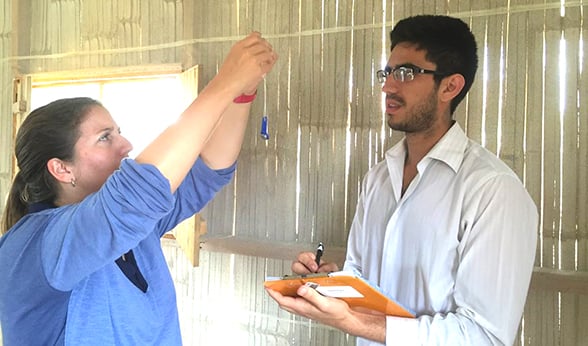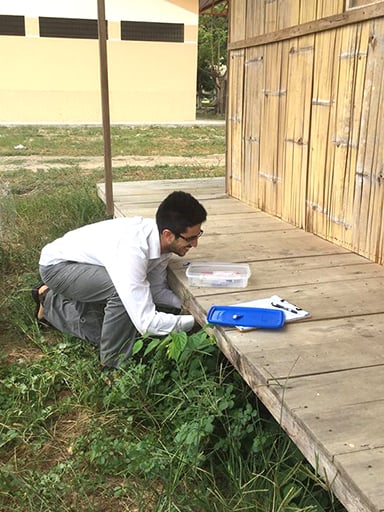Within days of graduating with a master’s in public health, Naveed Heydari flew to the tropics of Ecuador, a hot spot for Dengue virus and, just this year, confirmed cases of the dangerous and much-publicized Zika virus.
Heydari studied Environmental and Occupational Health at the Colorado School of Public Health (ColoradoSPH) and already has a big job to do. He’s leading a team of researchers for a long-term research program of the Center for Global Health & Translational Science (CGHTS) at the State University of New York (SUNY) Upstate. The program aims to stanch vector-borne viruses by learning what environmental conditions promote these diseases.
Just months before Heydari returned to Ecuador – he performed his practicum in Machala last summer – the World Health Organization sounded the alarm over Zika, saying the virus was “spreading explosively” across the Americas. In recent studies, according to the National Science Foundation, Machala had the highest abundance of Aedes aegypti larvae (the mosquito that carries Zika, Dengue and chikungunya viruses) of all sites surveyed in 10 countries in Latin America and Asia.
Top health concern
Machala, a port city in southern Ecuador, provides perfect egg-laying habitat for Aedes aegypti, which find the crowded conditions of lower-income neighborhoods especially hospitable. “Here, especially in the coastal areas, infectious diseases and these mosquito-borne illnesses are the No. 1 health concern for the public and the Ministry of Public Health,” Heydari says. “They’re a product of lack of infrastructure and inequities in housing. You see the higher burden of the disease in the disadvantaged communities.”
This summer, Heydari led a team of 17 researchers and eight students, including three from the ColoradoSPH – Reese Garcia, Jiayi Liew, and Keith Suter. Upstate Medical University in New York is the lead institution on the collaborative project, which is outlined on this Facebook page.
 Sadie J. Ryan, medical geographer at the University of Florida's Emerging Pathogens Institute, and Naveed Heydari, an alumnus of the Colorado School of Public Health, deploy a mini-sensor that measures temperature and humidity in a cane-constructed house in Machala, Ecuador, as part of their study into vector-borne viruses.
Sadie J. Ryan, medical geographer at the University of Florida's Emerging Pathogens Institute, and Naveed Heydari, an alumnus of the Colorado School of Public Health, deploy a mini-sensor that measures temperature and humidity in a cane-constructed house in Machala, Ecuador, as part of their study into vector-borne viruses.
The idea is to study the “risk landscape” of mosquito-borne pathogens, allowing scientists and public health officials to guard against future illness. “If you know what the risk factors are, you can predict where these outbreaks will be,” Heydari says. “And if you know that, you can use resources to stop the outbreaks before they occur.”
‘Passionate about this’
Garcia, Liew and Suter will return to CU Anschutz Medical Campus this academic year to present their capstone projects, while Heydari expects to work in Ecuador on the front lines of this public health threat for at least a couple more years. “The more you get into this work, the more you realize, ‘Wow, I love this!’” he says. “I’m really passionate about it.”
[perfectpullquote align="right" cite="" link="" color="" class="" size=""]Ecuador is one of 26 countries in the Americas that has reported Zika virus transmission, according to the U.S. Centers for Disease Control and Prevention. Brazil remains the hardest-hit country, with 1,600 confirmed cases of microcephaly – infants with abnormally small heads – linked to the virus. In addition to its vector-borne illness study, Heydari’s team is providing continued assistance to victims of Ecuador’s April earthquake. Heydari noted that the Upstate Foundation international funding site is still open and accepting donations.[/perfectpullquote]
A class in his MPH program at ColoradoSPH – Infectious Disease and Environmental Context, taught by Beth Carlton, PhD, MPH, assistant professor, Environmental and Occupational Health, and Rosemary Rochford, PhD, professor of Immunology-Microbiology, SOM, and Environmental and Occupational Health – fueled Heydari’s passion for this project. Meanwhile, Ecuador feels familiar to Heydari as his mother is a native Ecuadoran and he visited the country previous to his practicum.
Heydari, who earned his bachelor’s degree in economics from Northwestern University, focused his capstone study on the economic burden imposed on households in the prevention of mosquito control. One of his findings: in general, households in Machala spend about 2 percent of their total income on mosquito control.
By collecting weather data and social information, such as household income and how much is spent on mosquito control, the team hopes to learn the socioeconomic and environmental conditions that put people most at risk for the vector-borne illnesses.
Multi-pronged study
Heydari says his team is conducting a multi-pronged study:
- Diagnostics of Zika, Dengue and chikungunya viruses in community members who are suspected of possible infection.
- Mosquito collection by using vacuums mounted on backpacks. The vectors are classified and sent to a lab in Quito, Ecuador, where viruses carried by the mosquitoes are identified.
- Household surveys that provide insight into risk factors that predict infectious disease: Factors include homes that have interruptions in water supply, forcing the use of standing water containers that attract mosquitoes; trash around the house; number of people living in the home; amount of shade around house. Also, surveys asking residents how seriously they take threats of vector-borne illnesses and what interventions they use to control mosquitoes.
- Install climate sensors in homes. The sensors provide information about micro climates – temperature, humidity, etc. – that make homes conducive to mosquito exposure.
The research is focused on environmental factors such as climatic conditions that translate to human exposure and socio-economic factors such as housing type, household size and wealth.
 Naveed Heydari, an alumnus of the Colorado School of Public Health, studies how conducive a house in Machala, Ecuador, is for the transmission of vector-borne pathogens.
Naveed Heydari, an alumnus of the Colorado School of Public Health, studies how conducive a house in Machala, Ecuador, is for the transmission of vector-borne pathogens.
“It all comes together to paint a nice narrative of the burden of the disease here,” Heydari says. “We’re really trying to capture just what is the economic burden of the diseases and how we can strengthen our surveillance system.”
The Upstate Medical University research project is among nine projects to collectively receive $1.7 million in rapid response, or RAPID, grants from the National Science Foundation (NSF). Upstate’s study, which received nearly $200,000, is led by Anna Stewart Ibarra, PhD, MPA, a faculty member in the Department of Medicine and director of the Latin America Research Program in the CGHTS.
Stewart Ibarra is joined in the project by co-investigators Timothy Endy, MD, MPH, chief of infectious disease at Upstate and a founding member of the CGHTS; Marco Neira, PhD, assistant professor at Center for Infectious Disease Research, Pontifical Catholic University of Ecuador; and Sadie J. Ryan, PhD, MPH, medical geographer at the University of Florida's Emerging Pathogens Institute.
‘Good research platform’
Heydari says the project has provided a “good research platform” on which to apply interdisciplinary research – clinical-, sociological survey- and mathematical model-based approaches – toward the overall goal of safeguarding human health.
“You don’t get this kind of coordination and universities coming down to this part of Ecuador doing this kind of project,” Heydari says. “The researchers understand they’re doing work that has really significant implications. That’s what brought me back.”
The team received permission from the Ministry of Health to expand its work into two other southern Ecuadoran cities. The sites allow data collection in cities of varying elevation, climate and socioeconomic factors, as well as amount of vector-borne illnesses.
The scientists hope to discover when and where interventions might be most effective. The vaccine for Dengue is found to have a 60 percent efficacy rate. Heydari says he and Suter, continuing last year’s economic study, are asking residents if they’d be willing to pay for the Dengue vaccine. They will forward their findings to the Ecuador Ministry of Health and other stakeholders.
Safeguarding worker health
The collaboration extends to the local university – Technical University of Machala – where Heydari’s team uses an entomology lab and provides English lessons to the locals, who return the favor by teaching Spanish to the research group.
Heydari wants to expand on the research platform in Machala by bringing in more investigators to perform clinical trials on potential vaccines. He enjoys the freedom he’s been given by Upstate, and wants to branch out into new areas of study. “Another of my interests is worker health,” he says. “I’d like to look into pesticide use and see how it’s affecting workers in this hot, tropical climate.”
He hopes to return to Colorado next spring when Suter, Liew and Garcia present their capstones in their final semester. Heydari flourished at the ColoradoSPH and he looks forward to visiting his many friends on the CU Anschutz campus.
“I took one class (in the ColoradoSPH) and that was enough to get me hooked,” he says. “I had such a good relationship with the faculty and my peers. We had that shared vision of wanting to help others.”
